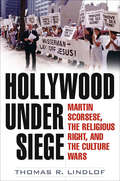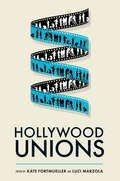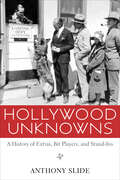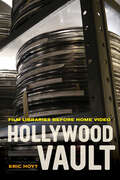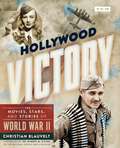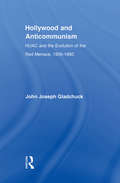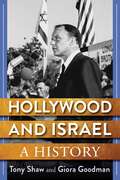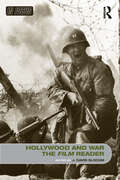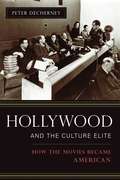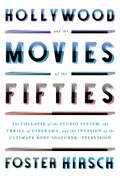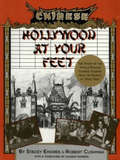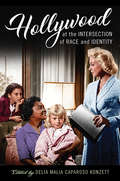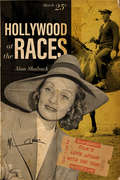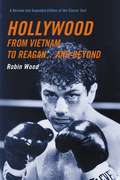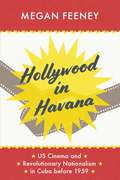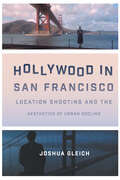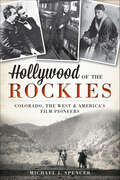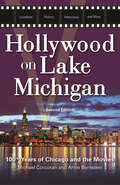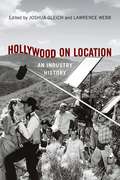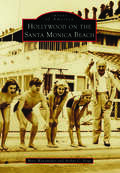- Table View
- List View
Hollywood Under Siege: Martin Scorsese, the Religious Right, and the Culture Wars
by Thomas R. LindlofA behind-the-scenes look at the making of The Last Temptation of Christ and the controversy following its release.In 1988, director Martin Scorsese fulfilled his lifelong dream of making a film about Jesus Christ. Rather than celebrating the film as a statement of faith, churches and religious leaders immediately went on the attack, alleging blasphemy. At the height of the controversy, thousands of phone calls a day flooded the Universal switchboard, and before the year was out, more than three million mailings protesting the film fanned out across the country. For the first time in history, a studio took responsibility for protecting theaters and scrambled to recruit a “field crisis team” to guide The Last Temptation of Christ through its contentious American openings. Overseas, the film faced widespread censorship actions, with thirteen countries eventually banning the film. The response in Europe turned violent when opposition groups sacked theaters in France and Greece and caused injuries to dozens of moviegoers.Twenty years later, author Thomas R. Lindlof offers a comprehensive account of how this provocative film came to be made and how Universal Pictures and its parent company MCA became targets of the most intense, unremitting attacks ever mounted against a media company. The film faced early and determined opposition from elements of the religious Right when it was being developed at Paramount during the last year the studio was run by the celebrated troika of Barry Diller, Michael Eisner, and Jeffrey Katzenberg. By the mid-1980s, Scorsese’s film was widely regarded as unmakeable?a political stick of dynamite that no one dared touch. Through the joint efforts of two of the era’s most influential executives, CAA president Michael Ovitz and Universal Pictures chairman Thomas P. Pollock, this improbable project found its way into production. The making of The Last Temptation of Christ caught evangelical Christians at a moment when they were suffering a crisis of confidence in their leadership. The religious right seized on the film as a way to rehabilitate its image and to mobilize ordinary citizens to attack liberalism in art and culture. The ensuing controversy over the film’s alleged blasphemy escalated into a full-scale war fought out very openly in the media. Universal/MCA faced unprecedented calls for boycotts of its business interests, anti-Semitic rhetoric and death threats were directed at MCA chairman Lew Wasserman and other MCA executives, and the industry faced the specter of violence at theaters.Hollywood Under Siege draws upon interviews with many of the key figures?Martin Scorsese, Paul Schrader, Michael Ovitz, Jeffrey Katzenberg, Jack Valenti, Thomas P. Pollock, and Willem Dafoe?to explore the trajectory of the film from its conception to the subsequent epic controversy and beyond. Lindlof offers a fascinating dissection of a critical episode in the embryonic culture wars, illuminating the explosive effects of the clash between the interests of the media industry and the forces of social conservatism.Praise for Hollywood Under Siege“No other book has traced the development of a major motion picture from conception through production to reception with the kind of care and detail that Lindlof does here. Hollywood Under Siege provides valuable insight into the machinery of the film industry, and into the machinations of American culture on a broader front as well.” —Thomas Schatz, author of The Genius of the System: Hollywood Filmmaking in the Studio Era and Executive Director of the University of Texas Film Institute“Riveting and accurate. Even though I thought I knew the events, I found myself captured anew.” —Paul Schrader, screenwriter and director“As a study of a landmark moment in American cinema, Lindlof’s book is both profound and extremely entertaining.” —Los Angeles Times“Lindlof has meticulously researched the histo
Hollywood Unions
by Barbara Hall Helen Warner Miranda J. Banks Paul Monticone Maya Montañez Smukler Adrienne L. McLean Luci Marzola Katie Bird Kate Fortmueller Dawn Fratini Erin HillHollywood Unions is a unique collection that tells the stories of the unions and guilds that have organized motion picture and television labor: IATSE, the DGA, SAG-AFTRA, and the WGA. The Hollywood unions represent a wide swath of the workers making media: from directors and stars to grips and makeup artists. People today know some of these organizations from their glitzy annual awards celebrations, but the unions’ actual importance is in bargaining with the Association of Motion Picture and Television Producers (AMPTP) on behalf of 331,000 workers in the motion picture and television industry. The Hollywood unions are not neutral institutions but rather have long histories of jurisdictional battles, competitions with rival unions, and industry-altering strikes. They have supported the industry’s workers through the Great Depression, World War II, the McCarthy era, the collapse of the studio system, the rise of television, runaway production, fights for gender parity, the digital revolution, and a global pandemic. The history of these unions has contributed to making media work sustainable in the long term and helped shape the conditions and production cultures of Hollywood.
Hollywood Unknowns: A History of Extras, Bit Players, and Stand-Ins
by Anthony SlideExtras, bit players, and stand-ins have been a part of the film industry almost from its conception. On a personal and a professional level, their stories are told in Hollywood Unknowns, the first history devoted to extras from the silent era through the present. Hollywood Unknowns discusses the relationship of the extra to the star, the lowly position in which extras were held, the poor working conditions and wages, and the sexual exploitation of many of the hardworking women striving for a place in Hollywood society. Though mainly anonymous, many are identified by name and, for perhaps the first time, receive equal billing with the stars. And Hollywood Unknowns does not forget the bit players, stand-ins, and doubles, who work alongside the extras facing many of the same privations. Celebrity extras, silent stars who ended their days as extras, or members of various ethnic groups—all gain a deserved luster in acclaimed film writer Anthony Slide's prose. Chapters document the lives and work of extras from the 1890s to the present. Slide also treats such subjects as the Hollywood Studio Club, Central Casting, the extras in popular literature, and the efforts at unionization through the Screen Actors Guild from the 1930s onwards. Slide chronicles events such as John Barrymore's walking off set in the middle of the day so the extras could earn another day's wages, and Cecil B. DeMille's masterful organizing of casts of thousands in films such as Cleopatra. Through personal interviews, oral histories, and the use of newly available archival material, Slide reveals in Hollywood Unknowns the story of the men, women, and even animals that completed the scenes on the silver screen.
Hollywood Vault: Film Libraries before Home Video
by Eric HoytHollywood Vault is the story of how the business of film libraries emerged and evolved, spanning the silent era to the sale of feature libraries to television. Eric Hoyt argues that film libraries became valuable not because of the introduction of new technologies but because of the emergence and growth of new markets, and suggests that studying the history of film libraries leads to insights about their role in the contemporary digital marketplace. The history begins in the mid-1910s, when the star system and other developments enabled a market for old films that featured current stars. After the transition to films with sound, the reissue market declined but the studios used their libraries for the production of remakes and other derivatives. The turning point in the history of studio libraries occurred during the mid to late 1940s, when changes in American culture and an industry-wide recession convinced the studios to employ their libraries as profit centers through the use of theatrical reissues. In the 1950s, intermediary distributors used the growing market of television to harness libraries aggressively as foundations for cross-media expansion, a trend that continues today. By the late 1960s, the television marketplace and the exploitation of film libraries became so lucrative that they prompted conglomerates to acquire the studios. The first book to discuss film libraries as an important and often underestimated part of Hollywood history, Hollywood Vault presents a fascinating trajectory that incorporates cultural, legal, and industrial history.
Hollywood Victory: The Movies, Stars, and Stories of World War II (Turner Classic Movies)
by Christian BlauveltFrom the Turner Classic Movies Library: Film and history buffs alike will enjoy this engrossing story of Hollywood's involvement in World War II, as it's never before been told.Remember a time when all of Hollywood—with the expressed encouragement and investment of the government—joined forces to defend the American way of life? It was World War II and the gravest threat faced the nation, and the world at large. Hollywood answered the call to action.This is the riveting tale of how the film industry enlisted in the Allied effort during the second World War—a story that started with staunch isolationism as studios sought to maintain the European market and eventually erupted into impassioned support in countless ways. Industry output included war films depicting battles and reminding moviegoers what they were fighting for, "home-front" stories designed to boost the morale of troops overseas, and even musicals and comedies that did their bit by promoting the Good Neighbor Policy with American allies to the south. Stars like Carole Lombard—who lost her life returning from a war bond-selling tour—Bob Hope, and Marlene Dietrich enthusiastically joined USO performances and risked their own health and safety by entertaining troops near battlefronts; others like James Stewart and Clark Gable joined the fight themselves in uniform; Bette Davis and John Garfield created a starry haven for soldiers in their founding of the Hollywood Canteen. Filmmakers Orson Welles, Walt Disney, Alfred Hitchcock, and others took breaks from thriving careers to make films aiming to shore up alliances, boost recruitment, and let the folks back home know what beloved family members were facing overseas. Through it all, a story of once-in-a-century unity—of a collective need to stand up for humanity, even if it means risking everything—comes to life in this engrossing, photo-filled tale of Hollywood Victory.
Hollywood and Anticommunism: HUAC and the Evolution of the Red Menace, 1935-1950 (Studies in American Popular History and Culture)
by John J. GladchukThis work concentrates on tracing the evolution of the so-called "red menace" phenomenon as a means of demonstrating the correlation between growing American paranoia and the success of the anticommunist campaign (1935-1955). The House Committee on Un-American Activities 1947 investigation of Hollywood, the nation's most visible industry, served a critical role in conjuring up anti-red hysteria and fanning the flames of virulent anticommunism. Using conveniently unjust tactics, the Committee "painted" targeted Hollywood personalities red and established the infamous blacklist - certified proof in the minds of many that "subversives" were indeed conspiring from within. A failed attempt on behalf of the "Hollywood Ten" to demonstrate the Committee’s undemocratic nature allowed HUAC to forge ahead with its investigation and establish the anticommunist foundation upon which Joseph McCarthy would construct his campaign. Hollywood and Anticommunism stands as an important contribution to McCarthy-era literature and should appeal to all interested in the early Cold War and the impact that unwarranted hysteria has had and continues to have on the growth and development of the nation.
Hollywood and Hitler 1933-1939
by Thomas DohertyThe behind-the-scenes story of Hollywood's struggle with Nazism before the outbreak of war.
Hollywood and Hitler, 1933-1939 (Film and Culture Series)
by Thomas DohertyBetween 1933 and 1939, representations of the Nazis and the full meaning of Nazism came slowly to Hollywood, growing more ominous and distinct only as the decade wore on. Recapturing what ordinary Americans saw on the screen during the emerging Nazi threat, Thomas Doherty reclaims forgotten films, such as Hitler's Reign of Terror (1934), a pioneering anti-Nazi docudrama by Cornelius Vanderbilt Jr.; I Was a Captive of Nazi Germany (1936), a sensational true tale of "a Hollywood girl in Naziland!"; and Professor Mamlock (1938), an anti-Nazi film made by German refugees living in the Soviet Union. Doherty also recounts how the disproportionately Jewish backgrounds of the executives of the studios and the workers on the payroll shaded reactions to what was never simply a business decision. As Europe hurtled toward war, a proxy battle waged in Hollywood over how to conduct business with the Nazis, how to cover Hitler and his victims in the newsreels, and whether to address or ignore Nazism in Hollywood feature films. Should Hollywood lie low, or stand tall and sound the alarm?Doherty's history features a cast of charismatic personalities: Carl Laemmle, the German Jewish founder of Universal Pictures, whose production of All Quiet on the Western Front (1930) enraged the nascent Nazi movement; Georg Gyssling, the Nazi consul in Los Angeles, who read the Hollywood trade press as avidly as any studio mogul; Vittorio Mussolini, son of the fascist dictator and aspiring motion picture impresario; Leni Riefenstahl, the Valkyrie goddess of the Third Reich who came to America to peddle distribution rights for Olympia (1938); screenwriters Donald Ogden Stewart and Dorothy Parker, founders of the Hollywood Anti-Nazi League; and Harry and Jack Warner of Warner Bros., who yoked anti-Nazism to patriotic Americanism and finally broke the embargo against anti-Nazi cinema with Confessions of a Nazi Spy (1939).
Hollywood and Israel: A History
by Tony Shaw Giora GoodmanFrom Frank Sinatra’s early pro-Zionist rallying to Steven Spielberg’s present-day peacemaking, Hollywood has long enjoyed a “special relationship” with Israel. This book offers a groundbreaking account of this relationship, both on and off the screen. Tony Shaw and Giora Goodman investigate the many ways in which Hollywood’s moguls, directors, and actors have supported or challenged Israel for more than seven decades. They explore the complex story of Israel’s relationship with American Jewry and illuminate how media and soft power have shaped the Arab-Israeli conflict.Shaw and Goodman draw on a vast range of archival sources to demonstrate how show business has played a pivotal role in crafting the U.S.-Israel alliance. They probe the influence of Israeli diplomacy on Hollywood’s output and lobbying activities, but also highlight the limits of ideological devotion in high-risk entertainment industries. The book details the political involvement with Israel—and Palestine—of household names such as Eddie Cantor, Kirk Douglas, Elizabeth Taylor, Barbra Streisand, Vanessa Redgrave, Arnold Schwarzenegger, Robert De Niro, and Natalie Portman. It also spotlights the role of key behind-the-scenes players like Dore Schary, Arthur Krim, Arnon Milchan, and Haim Saban.Bringing the story up to the moment, Shaw and Goodman contend that the Hollywood-Israel relationship might now be at a turning point. Shedding new light on the political power that images and celebrity can wield, Hollywood and Israel shows the world’s entertainment capital to be an important player in international affairs.
Hollywood and War, The Film Reader (In Focus: Routledge Film Readers Ser.)
by J. David SlocumDiscussing such classic films as Sergeant York, Air Force, and All Quiet on the Western Front, as well as more modern blockbusters like Apocalypse Now and Saving Private Ryan, this outstanding volume focuses on Hollywood and its production of war films.Topics covered include:the early formation of war cinemathe apotheosis of the Hollywood war filmthe ascendancy of ambivalenceHollywood and the war since Vietnamwar as a way of seeing. For any student of film studies or American cultural studies, this is a valuable companion.
Hollywood and the Culture Elite: How the Movies Became American
by Peter DecherneyPeter Decherney explores how the concerns of intellectuals and the needs of Hollywood studio heads led to the development of a mutually beneficial relationship during Hollywood's Golden Age (1915-1960). During this period, museums, universities, and government agencies used films to maintain their position as quintessential American institutions, transforming movies into an art form and making moviegoing a vital civic institution. Decherney's history features an intriguing cast of characters, including the poet Vachel Lindsay, film producers Adolph Zukor and Joseph Kennedy, Hollywood flak Will Hays, and philanthropist Nelson Rockefeller. He shows how Columbia and Harvard started film studies programs in the 1910s and 1920s to remake American education and American culture. And he shows how the Museum of Modern Art, the U.S. Office of War Information, and the National Endowment for the Arts worked with Hollywood to fight fascism and communism and to promote American values abroad. Hollywood and the Culture Elite offers a unique glimpse into the collaboration between Hollywood and the stewards of high culture to ensure their own survival and profitability.
Hollywood and the Culture Elite: How the Movies Became American (Film and Culture Series)
by Peter DecherneyAs Americans flocked to the movies during the first part of the twentieth century, the guardians of culture grew worried about their diminishing influence on American art, education, and American identity itself. Meanwhile, Hollywood studio heads were eager to stabilize their industry, solidify their place in mainstream society, and expand their new but tenuous hold on American popular culture. Peter Decherney explores how these needs coalesced and led to the development of a symbiotic relationship between the film industry and America's stewards of high culture. Formed during Hollywood's Golden Age (1915-1960), this unlikely partnership ultimately insured prominent places in American culture for both the movie industry and elite cultural institutions. It redefined Hollywood as an ideal American industry; it made movies an art form instead of simply entertainment for the masses; and it made moviegoing a vital civic institution. For their part, museums and universities used films to maintain their position as quintessential American institutions.As the book delves into the ties between Hollywood bigwigs and various cultural leaders, an intriguing cast of characters emerges, including the poet Vachel Lindsay, film producers Adolph Zukor and Joseph Kennedy, Hollywood flak and censor extraordinaire Will Hays, and philanthropist turned politician Nelson Rockefeller. Decherney considers how Columbia University's film studies program helped integrate Jewish students into American culture while also professionalizing screenwriting. He examines MoMA's career-savvy film curator Iris Barry, a British feminist once dedicated to stemming the tide of U.S. cultural imperialism, who ultimately worked with Hollywood and the U.S. government to fight fascism and communism and promote American values abroad. Other chapters explore Vachel Lindsay's progressive vision of movies as reinvigorating the public sphere through film libraries and museums; the promotion of movie connoisseurship at Harvard and other universities; and how the heir of a railroad magnate bankrolled the American avant-garde film movement. Amid ethnic diversity, the rise of mass entertainment, world war, and the global spread of American culture, Hollywood and cultural institutions worked together to insure their own survival and profitability and to provide a coherent, though shifting, American identity.
Hollywood and the Movies of the Fifties: The Collapse of the Studio System, the Thrill of Cinerama, and the Invasion of the Ultimate Body Snatcher--Television
by Foster HirschA fascinating look at Hollywood&’s most turbulent decade and the demise of the studio system—set against the boom of the post–World War II years, the Cold War, and the atomic age—and the movies that reflected the seismic shiftsHollywood in the 1950s was a period when the film industry both set conventions and broke norms and traditions—from Cinerama, CinemaScope, and VistaVision to the epic film and lavish musical. It was a decade that saw the rise of the anti-hero; the smoldering, the hidden, and the unspoken; teenagers gone wild in the streets; the sacred and the profane; the revolution of the Method; the socially conscious; the implosion of the studios; the end of the production code; and the invasion of the ultimate body snatcher: the &“small screen&” television.Here is Eisenhower&’s America—seemingly complacent, conformity-ridden revealed in Vincente Minnelli&’s Father of the Bride, Walt Disney&’s Cinderella, and Brigadoon, among others.And here is its darkening, resonant landscape, beset by conflict, discontent, and anxiety (The Man Who Knew Too Much, The Asphalt Jungle, A Place in the Sun, Touch of Evil, It Came From Outer Space) . . . an America on the verge of cultural, political and sexual revolt, busting up and breaking out (East of Eden, From Here to Eternity, On the Waterfront, Sweet Smell of Success, The Wild One, A Streetcar Named Desire, and Jailhouse Rock).An important, riveting look at our nation at its peak as a world power and at the political, cultural, sexual upheavals it endured, reflected and explored in the quintessential American art form.
Hollywood at Your Feet
by Stacey Endres Robert Cushman Ginger RogersBuilt by Sid Grauman in 1927, the most famous motion picture palace in the world towers majestically above the 6900 block of Hollywood Boulevard. The Chinese Theatre's Forecourt of the Stars attracts more than two million visitors annually. Throughout its history and up to the present day, the theatre has served as a magnet to thousands of fans and tourists who flock to the site daily to view the flamboyant architecture and the historic cement squares in the theatre's forecourt. The footprints, handprints, and signatures of 176 of Hollywood's most famous celebrities have been placed here, plus those of three comedy teams, one group of quintuplets, two robots and a villainous sci-fi character, on ventriloqist's dummy, a radio character, and the world's best known duck.
Hollywood at the Intersection of Race and Identity
by Ellen C. Scott Delia Malia Konzett Jonna Eagle Louise Wallenberg Dean Itsuji Saranillio Charlene Regester Ryan Jay Friedman Ruth Mayer Alice Maurice Matthias Konzett Chris Cagle Graham Cassano Priscilla Peña Ovalle Ernesto R Acevedo-Muñoz Mary Beltrán Jun OkadaHollywood at the Intersection of Race and Identity explores the ways Hollywood represents race, gender, class, and nationality at the intersection of aesthetics and ideology and its productive tensions. This collection of essays asks to what degree can a close critical analysis of films, that is, reading them against their own ideological grain, reveal contradictions and tensions in Hollywood’s task of erecting normative cultural standards? How do some films perhaps knowingly undermine their inherent ideology by opening a field of conflicting and competing intersecting identities? The challenge set out in this volume is to revisit well-known films in search for a narrative not exclusively constituted by the Hollywood formula and to answer the questions: What lies beyond the frame? What elements contradict a film’s sustained illusion of a normative world? Where do films betray their own ideology and most importantly what intersectional spaces of identity do they reveal or conceal?
Hollywood at the Races: Film's Love Affair with the Turf
by Alan Shuback“An informative and amusing look at the close relationship between Golden Age Hollywood and West Coast horse racing. A fascinating read.” —Christina Rice, author of Mean . . . Moody . . . Magnificent!Horse racing was so popular and influential between 1930 and 1960 that nearly 150 racing themed films were released, including A Day at the Races, Thoroughbreds Don’t Cry, and National Velvet.This fast-paced, gossipy history explores the relationship between the Hollywood film industry, the horse racing industry, and the extraordinary participation of producers, directors, and actors in the Sport of Kings. Alan Shuback details how all three of Southern California’s major racetracks were founded by Hollywood luminaries: Hal Roach was cofounder of Santa Anita Park, Bing Crosby founded Del Mar with help from Pat O’Brien, and Jack and Harry Warner founded Hollywood Park with help from dozens of people in the film community.The races also provided a social and sporting outlet for the film community—studios encouraged film stars to spend a day at the races, especially when a new film was being released. The stars’ presence at the track generated a bevy of attention from eager photographers and movie columnists, as well as free publicity for their new films. Moreover, Louis B. Mayer, Bing Crosby, Fred Astaire, Betty Grable, and Don Ameche were all major Thoroughbred owners, while Mickey Rooney, Chico Marx, and John Huston were notorious for their unsuccessful forays to the betting windows.“The more entertaining vignettes pair the names of old-time screen stars with ribald tales of racetrack depravity.” —Thoroughbred Daily News
Hollywood from Vietnam to Reagan . . . and Beyond
by Robin WoodThis classic of film criticism, long considered invaluable for its eloquent study of a problematic period in film history, is now substantially updated and revised by the author to include chapters beyond the Reagan era and into the twenty-first century. For the new edition, Robin Wood has written a substantial new preface that explores the interesting double context within which the book can be read-that in which it was written and that in which we find ourselves today. Among the other additions to this new edition are a celebration of modern "screwball" comedies like My Best Friend's Wedding, and an analysis of '90s American and Canadian teen movies in the vein of American Pie, Can't Hardly Wait, and Rollercoaster. Also included are a chapter on Hollywood today that looks at David Fincher and Jim Jarmusch (among others) and an illuminating essay on Day of the Dead.
Hollywood in Havana: US Cinema and Revolutionary Nationalism in Cuba before 1959
by Megan FeeneyFrom the turn of the twentieth century through the late 1950s, Havana was a locus for American movie stars, with glamorous visitors including Errol Flynn, John Wayne, and Marlon Brando. In fact, Hollywood was seemingly everywhere in pre-Castro Havana, with movie theaters three to a block in places, widely circulated silver screen fanzines, and terms like “cowboy” and “gangster” entering Cuban vernacular speech. Hollywood in Havana uses this historical backdrop as the catalyst for a startling question: Did exposure to half a century of Hollywood pave the way for the Cuban Revolution of 1959? Megan Feeney argues that the freedom fighting extolled in American World War II dramas and the rebellious values and behaviors seen in postwar film noir helped condition Cuban audiences to expect and even demand purer forms of Cuban democracy and national sovereignty. At the same time, influential Cuban intellectuals worked to translate Hollywood ethics into revolutionary rhetoric—which, ironically, led to pointed critiques and subversions of the US presence in Cuba. Hollywood in Havana not only expands our notions of how American cinema was internalized around the world—it also broadens our view of the ongoing history of US-Cuban interactions, both cultural and political.
Hollywood in San Francisco: Location Shooting and the Aesthetics of Urban Decline (Texas Film and Media Studies Series)
by Joshua GleichOne of the country&’s most picturesque cities and conveniently located just a few hours&’ drive from Hollywood, San Francisco became the most frequently and extensively filmed American city beyond the production hubs of Los Angeles and New York in the three decades after World War II. During those years, the cinematic image of the city morphed from the dreamy beauty of Vertigo to the nightmarish wasteland of Dirty Harry, although San Francisco itself experienced no such decline. This intriguing disconnect gives impetus to Hollywood in San Francisco, the most comprehensive study to date of Hollywood&’s move from studio to location production in the postwar era. In this thirty-year history of feature filmmaking in San Francisco, Joshua Gleich tracks a sea change in Hollywood production practices, as location shooting overtook studio-based filming as the dominant production method by the early 1970s. He shows how this transformation intersected with a precipitous decline in public perceptions of the American city, to which filmmakers responded by developing a stark, realist aesthetic that suited America&’s growing urban pessimism and superseded a fidelity to local realities. Analyzing major films set in San Francisco, ranging from Dark Passage and Vertigo to The Conversation, The Towering Inferno, and Bullitt, as well as the TV show The Streets of San Francisco, Gleich demonstrates that the city is a physical environment used to stage urban fantasies that reveal far more about Hollywood filmmaking and American culture than they do about San Francisco.
Hollywood in the Sixties
by John BaxterHollywood in the 1960s is not truly Hollywood, but a factory whose product lacks the magic of earlier decades. Perhaps some magic will accrue over the years, but once we are aware of its mechanics will the alchemy continue to work? Like the cartoon characters, we remain suspended in the air only as long as we are unaware of being so; as soon as we look down, we fall.
Hollywood of the Rockies: Colorado, the West and America's Film Pioneers
by Michael J. SpencerIn the early days of the twentieth century, movies weren't made in California. As America's film pioneers traveled westward, Colorado became a beacon to them, contributing to the early motion picture business with all the relish and gusto of a western saga. The gorgeous natural scenery was perfect for the country's (and the world's) growing infatuation with the West, turning Colorado itself into a bigger star of the early cinema than any particular actor. Using rare photos and contemporary accounts, writer and filmmaker Michael J. Spencer explores the little-known filmmaking industry that flourished in the Rocky Mountains between 1895 and 1915--west of New York but east of Hollywood.
Hollywood on Lake Michigan: 100+ Years of Chicago and the Movies
by Michael Corcoran Arnie BernsteinRanging from the dawn of the silent era to today's blockbusters and independent films, this revamped second edition chronicles the significant contributions by Chicago and Chicagoans to more than a century of American filmmaking. Among the Windy City's unique honors in this history are the development of film technology by early major players Essanay Film Manufacturing Company and the Selig Polyscope Company; the first African American-owned and operated film studios; the birthplace of gore flicks; the origination and growth of movie palaces; and the importance of the Second City, Goodman, and Steppenwolf theaters as training grounds for the industry's best comedic and dramatic talent. Readers will relish behind-the-scenes stories of local favorites like The Blues Brothers and Ferris Bueller's Day Off, as well as recent box office smashes like Batman Begins and The Dark Knight. Fully revised and updated, this premier guide to the Windy City's history in the film industry features new profiles of film locations, more photographs, and exclusive interviews detailing all aspects of the moviemaking process, making it the perfect guide for film lovers and Chicago history buffs alike.
Hollywood on Location: An Industry History
by Julian Stringer Daniel Steinhart Sheri Chinen Biesen Jennifer Lynn Peterson Noelle GriffisLocation shooting has always been a vital counterpart to soundstage production, and at times, the primary form of Hollywood filmmaking. But until now, the industrial and artistic development of this production practice has been scattered across the margins of larger American film histories. Hollywood on Location is the first comprehensive history of location shooting in the American film industry, showing how this mode of filmmaking changed Hollywood business practices, production strategies, and visual style from the silent era to the present. The contributors explore how location filmmaking supplemented and later, supplanted production on the studio lots. Drawing on archival research and in-depth case studies, the seven contributors show how location shooting expanded the geography of American film production, from city streets and rural landscapes to far-flung territories overseas, invoking a new set of creative, financial, technical, and logistical challenges. Whereas studio filmmaking sought to recreate nature, location shooting sought to master it, finding new production values and production economies that reshaped Hollywood’s modus operandi.
Hollywood on the Santa Monica Beach (Images of America)
by Arthur C. Verge Marc WanamakerSince pioneer filmmakers arrived on its shoreline in the early 20th century, the Santa Monica beach has been a popular location for the making of movies and television productions. Its enchanting beauty led studio moguls, producers, and celebrities to build beach houses there, creating what became known as "Hollywood's Playground." The sand and shore of the Santa Monica beach became a favored site for the likes of Charlie Chaplin, Marion Davies, William Randolph Hearst, and Cary Grant. It was on this beach that the Academy Awards were conceived, the movie The Wizard of Oz sprang forth, and a young Pres. John F. Kennedy stunned beachgoers with a surprise ocean swim without the protection of Secret Service agents. In 1962, the beach became the center of the universe as the site of President Kennedy's "Western White House," where the visitors included Frank Sinatra, Dean Martin, Sammy Davis Jr., Marilyn Monroe, and--famously--"anyone who was anyone."
Hollywood v. Hard Core: How the Struggle Over Censorship Created the Modern Film Industry
by Jon LewisA tale of censorship and regulation at the heart of the modern film industryIn 1972, The Godfather and Deep Throat were the two most popular films in the country. One, a major Hollywood studio production, the other an independently made "skin flick." At that moment, Jon Lewis asserts, the fate of the American film industry hung in the balance.Spanning the 20th century, Hollywood v. Hard Core weaves a gripping tale of censorship and regulation. Since the industry's infancy, film producers and distributors have publicly regarded ratings codes as a necessary evil. Hollywood regulates itself, we have been told, to prevent the government from doing it for them. But Lewis argues that the studios self-regulate because they are convinced it is good for business, and that censorship codes and regulations are a crucial part of what binds the various competing agencies in the film business together. Yet between 1968 and 1973 Hollywood films were faltering at the box office, and the major studios were in deep trouble. Hollywood's principal competition came from a body of independently produced and distributed films—from foreign art house film Last Tango in Paris to hard-core pornography like Behind the Green Door—that were at once disreputable and, for a moment at least, irresistible, even chic. In response, Hollywood imposed the industry-wide MPAA film rating system (the origins of the G, PG, and R designations we have today) that pushed sexually explicit films outside the mainstream, and a series of Supreme Court decisions all but outlawed the theatrical exhibition of hard core pornographic films. Together, these events allowed Hollywood to consolidate its iron grip over what films got made and where they were shown, thus saving it from financial ruin.
